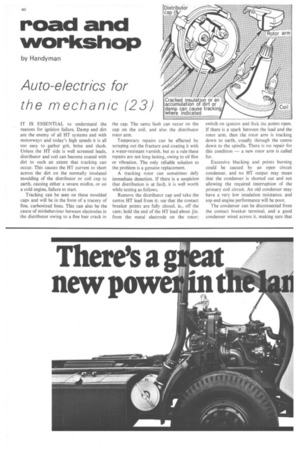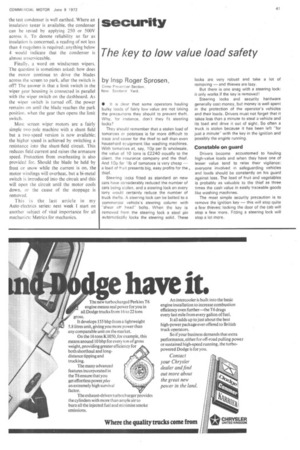road and workshop
Page 42

Page 43

If you've noticed an error in this article please click here to report it so we can fix it.
by Handyman
Auto-electrics for the mechanic (23)
IT IS ESSENTIAL to understand the reasons for ignition failure. Damp and dirt are the enemy of all HT systems and with motorways and today's high speeds it is all too easy to gather grit, brine and slush. Unless the HT side is well screened leads, distributor and coil can become coated with dirt to such an extent that tracking can occur. This causes the HT current to short across the dirt on the normally insulated moulding of the distributor or coil cap to earth, causing either a severe misfire, or on a cold engine, failure to start.
Tracking can be seen on these moulded caps and will be in the form of a tracery of fine, carbonized lines. This can also be the cause of misbehaviour between electrodes in the distributor owing to a fine hair crack in the cap. The same fault can occur on the cap on the coil, and also the distributor rotor arm.
Temporary repairs can be effected by scraping out the fracture and coating it with a water-resistant varnish, but as a rule these repairs are not long lasting, owing to oil film or vibration. The only reliable solution to the problem is a genuine replacement.
A tracking rotor can sometimes defy immediate detection. If there is a suspicion that distribution is at fault, it is well worth while testing as follows.
Remove the distributor cap and take the centre HT lead from it; see that the contact breaker points are fully closed, ie., off the cam; hold the end of the HT lead about lin. from the metal electrode on the rotor; switch on ignition and flick the points open. If there is a spark between the lead and the rotor arm, then the rotor arm is tracking down to earth, usually through the centre down to the spindle. There is no repair for this condition — a new rotor arm is called for.
Excessive blacking and points burning could be caused by an open circuit condenser, and no HT output may mean that the condenser is shorted out and not allowing the required interruption of the primary coil circuit. An old condenser may have a very low insulation resistance, and top-end engine performance will be poor.
The condenser can be disconnected from the contact breaker terminal, and a good condenser wired across it, making sure that
the test condenser is well earthed. Where an insulation tester is available, the condenser can be tested by applying 250 or 500V across it. To denote reliability so far as insulation is concerned, a reading of not less than 4 rnegohms is required: anything below 4 would indicate that the condenser is almost unserviceable.
Finally, a word on windscreen wipers. The question is sometimes asked: how does the motor continue to drive the blades across the screen to park, after the switch is off? The answer is that a limit switch in the wiper gear housimg is connected in parallel with the wiper switch on the dashboard. As the wiper switch is turned off, the power remains on until the blade reaches the park position. when the gear then opens the limit switch.
Most screen wiper motors are a fairly simple two-pole machine with a shunt field but a two-speed version is now available; the higher speed is achieved by switching a resistance into the shunt-field circuit. This reduces field current and raises the armature speed. Protection from overheating is also provided for. Should the blade be held by frost or snow while the current is on, the motor windings will overheat, but a bi-metal switch is introduced into the circuit and this will open the circuit until the motor cools down. or the cause of the stoppage is removed.
This is the last article in my Auto-electrics series: next week I start on another subject of vital importance for all mechanics: Metrics for mechanics.




































































































